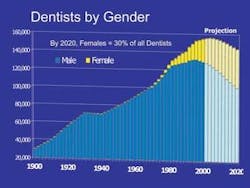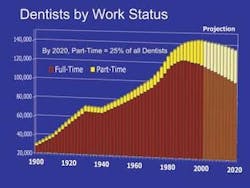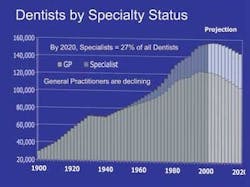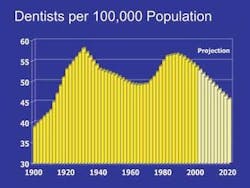The future of dentistry: Trends in economics and more
By Eric S. Solomon, DDS, MA
The first article in this series explored trends in dental education. We identified the major shifts in dental school enrollments that were influenced by both demographic and economic factors. Some of the important findings included the recent surge in dental hygiene graduates and the relatively stable level of dental school graduates. Also of great interest is the prospect of having more dentists retiring than there are dentists graduating. In this article we will demonstrate the impact of these enrollment trends on dental manpower levels.
Since 1900, the number of U.S. dentists generally has increased (Fig. 1). The one exception was during the Great Depression of the 1920s when the total number of dentists actually fell. Currently, however, the number of active U.S. dentists has almost peaked. As the anticipated number of dentists retiring rises above the number of dental school graduates, the total number of dentists in the United States will begin a slow decline. This should occur sometime toward the end of this decade. Economic conditions will have an impact when this occurs. Favorable economic conditions will encourage retirements, and poor economic conditions will discourage them. Irrespective of economic factors, dentistry will become the only major health profession with decreasing numbers sometime within the next decade. Because of relatively stable numbers of dental school graduates, the total number of active dentists in the United States should continue to decrease slowly until at least 2020.
Figure 1 also shows the total number of dentists by gender. Prior to the 1980s, female dentists were not a large segment of the dental workforce; fewer than 3 percent of all dentists in 1980 were female. There has been a rapid increase in female participation; women currently represent an estimated 19 percent of the dental workforce. Dental enrollment trends indicate that female participation should increase to some 30 percent of the dental workforce in 2020. As females become a larger segment of the dental workforce, the number of male dentists necessarily declines. These data indicate that the number of male dentists probably began to decline around the year 2000.
Not all dentists work full time. Figure 2 shows the number of dentists by work status (full-time vs. part-time). Full-time dentists are defined as working at least 30 hours per week. Historical data indicate that most dentists worked full time during the first half of the 20th century. In 1975, fewer than 10 percent of active dentists worked part time. The number of dentists working part time has increased during the past quarter century. Currently, an estimated 20 percent of all active dentists work part time. If current trends persist, one of four dentists (25 percent) could be working part time by 2020. This could significantly impact the effective manpower supply.
Recent data suggest a relationship between gender and work status. In 1999, female dentists younger than 40 years old were at least five times more likely to work part time than their male counterparts (5.6 percent vs. 31.3 percent). Female dentists between the ages of 40 and 59 were more than three times more likely to work part time (8.7 percent vs. 28.6 percent). Most dentists who are 60 or older are male, and about half work part time (46.2 percent). As the number of female dentists increases, their impact on the dental workforce will be significant if gender differences in work status persist.
Another relatively recent phenomenon is the growth in the proportion of dentists who are dental specialists (Fig. 3). Most of this growth has occurred during the past 30 years. In 1970, fewer than 10 percent of all active dentists were specialists. Currently, about 22 percent of dentists are specialists.
This percentage should increase slowly to about 27 percent by 2020. The number of both dental school graduates and specialty graduates has stabilized; therefore, it is unlikely that the proportion of dentists who are specialists will increase beyond the year 2020. A higher proportion of specialists means there are fewer general dentists.
In fact, the number of general dentists in the United States probably started declining sometime around the turn of the 20th century. The declining number of general dentists likely will continue throughout the projection period. There are potential consequences of this trend, particularly in the supply of dentists in non-urban areas. The overwhelming majority of specialists work in urban areas. As the number of general dentists decreases, it could have a negative impact on the supply of dentists in rural areas.
Thus far, we have examined trends in the number of dentists, but what about the number of dentists in relation to the population? The distribution of dentists in relation to the population (dentists per 100,000 people) is dramatically different than the distribution of dentists (Fig. 4).
The dentist-to-population ratio peaked twice during the 20th century; once prior to the Great Depression and again in the late 1980s. Since the late 1980s, the dentist-to-population ratio has been falling. The rate of decline thus far has been relatively slow. However, once the actual number of dentists begins to decline, this rate will increase. By 2020, the dentist-to-population ratio could be comparable to the ratio experienced during World War I.
Significant changes in dental manpower are underway. These changes will impact dental economic trends and the practice of dentistry. In the next article in this series, we will explore dental economic trends and see how the changes in dental manpower might influence future economic
Dr. Eric S. Solomon is executive director for institutional research at the Texas A&M Health Science Center and professor, Public Health Sciences, Baylor College of Dentistry. Prior to joining the Baylor College of Dentistry in 1992, Dr. Solomon served as the assistant executive director for application services and resource studies at the American Dental Education Association. He has published numerous articles and lectured widely on trends in dentistry, dental manpower, and dental education. Solomon may be reached by email at [email protected].




